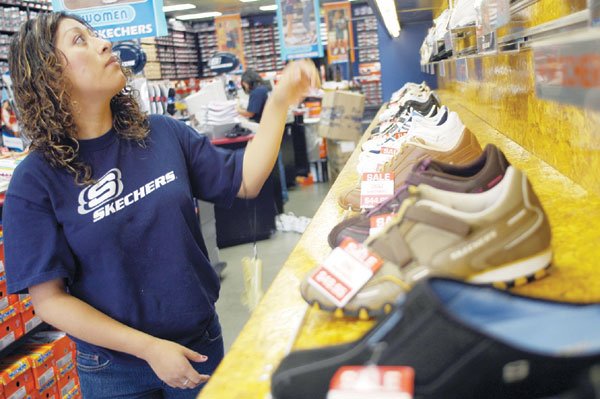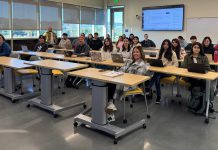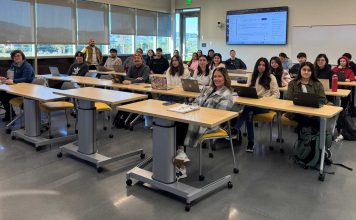Gilroy
– High school senior Aisha Zaza knew she wanted to work at
In-N-Out Burger during the summer. Right before school got out in
May, she headed straight to the family–run fast food chain. Within
half an hour, she completed the application, interview and was
hired.
That was two years ago.
”
I knew that they paid well. I had my heart set on working
here,
”
Zaza said.
”
Surprisingly, it hasn’t gotten old for me.
”
Unfortunately, not many teen-agers will have similar experiences
this year.
Gilroy – High school senior Aisha Zaza knew she wanted to work at In-N-Out Burger during the summer. Right before school got out in May, she headed straight to the family–run fast food chain. Within half an hour, she completed the application, interview and was hired.
That was two years ago.
“I knew that they paid well. I had my heart set on working here,” Zaza said. “Surprisingly, it hasn’t gotten old for me.”
Unfortunately, not many teen-agers will have similar experiences this year.
In a 2005 report from the Center for Labor Market Studies at Northeastern University, the number of employed teen-agers fell for the fourth straight year. And this summer isn’t looking much better.
The report indicated that employment is down from 45.2 percent in 2000 to 36.4 percent for 16- to 19–year-olds, and more than 3.5 percentage points from 72.2 percent in 2000 to 67.9 percent for 20- to 24–year–olds. Together, they represent the largest drop in employment rate for all age groups.
“There appears to be new structural forces at work in U.S. labor markets … a sharply diminished number of jobs in manufacturing, high levels of immigration, little net job growth in retail trade industries, rising competition from older adults… that are increasing the difficulties of teens obtaining jobs during the first few years of recovery from the recession of 2001,” the report stated.
But Skechers employee Ryan Andersen has another theory: “Most people my age are maybe lazy,” the 20–year-old Gavilan College student said.
Across Santa Clara County, the overall unemployment rate for May 2005 was 5.0 percent – lower than both the national unemployment rate (5.1 percent) and the state rate (5.3 percent.) However, in Gilroy, the unemployment rate for May was 7.2 percent.
“It’s been really tough this year,” said Gap General Manager Mike Mould. “We’ve been in a hiring slump for about a year.”
While there are 25 positions open at both the Gap and its sister store, Banana Republic, neither hire individuals under 18, Mould said.
They also do not usually hire for the summer season only, Mould explained.
Because of the state of the economy, those students a few years out of college and high school compete for part–time jobs traditionally held by high schoolers, Richard White, Director of Career Services at Rutgers University, said.
However, there is good news.
“Around the country, 2005 is the best time to be coming out of school since before 9/11,” said White. “For the class of 2005, whether it’s high school or college, their past four years have been defined by 9/11. They had just been in school a couple of weeks when the world changed … For them, the economy and job market has pretty much been defined by bad news.”
The last big boom in the labor market occurred in the late 1990s, before the crash of the dot–coms. After 9/11, the economy dipped and recovery has been slow.
“I think there was some hope that things would significantly improve in 2004,” White said, adding that it just hasn’t happened.
But students in Gilroy need not look too far: Both Bonfante Gardens and some retail shops at the Gilroy Outlets are still hiring – but the jobs are being snatched up quickly.
“You’re going to be behind if you wait,” said Timberland assistant store manager Lori Chavarria–Vallejo. “We’re doing interviews today.”
For Chavarria–Vallejo, the most important thing she looks for when hiring: Availability.
Besides a steady paycheck, students can expect a few perks while working.
Timberland offers health benefits to part–time workers and pays its staff to do community service. Not to mention, its employees get free shoes.
Billabong is another store that has been swamped with applications since the school year tapered. According to store manager Kelly Bennett, it has received between 30 and 40 inquiries from students.
While all eight summer positions have been filled, she did reveal what they look for in employees.
“We’re looking for people who are loud and outgoing with customer service experience … somebody that gets good grades,” she said.
The In-N-Out Burger in Gilroy thoroughly screens its applicants. Seven new employees have been added to the In-N-Out “family.”
Starting wage begins at $9.25 per hour, more than $2 above the state’s minimum wage, which is $6.75.
“We pay higher because we hire 10s,” said store trainer Ashley Gilbert, referring to the top quality individuals the firm hires.
Another route high school and college students are taking to find employment is local temp agencies.
“We’ve been getting a lot of 18- to 24–year–olds looking for clerical and industrial work,” said staffing specialist Mario Coronado of Manpower Staffing Services.
Coronado estimates that about three to four students come each day looking for job placement. Of those, between 50 and 75 percent will be placed, he said.
Regardless of the type of job high school students manage to snag this summer, it will benefit more than just their bank account.
“Colleges see value in those jobs,” said Shannon Duff, founder of Collegiate Compass LLC, an educational consulting firm that specializes in college admissions. “They want to see students who are willing to take the initiative.”
According to Duff, the vast majority of acceptance letters go to students who do more than just school.
“I think you can market in the (college) interview that you worked hard at the GAP or the local law firm (as an intern), though they have different sets of skills, both are marketable.”













